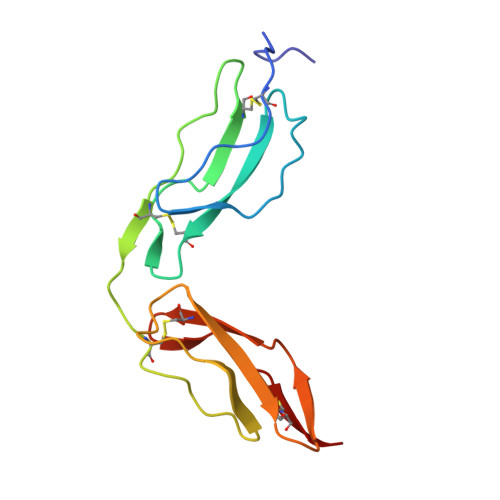Solution Structure of Ccp Modules 10-12 Illuminates Functional Architecture of the Complement Regulator, Factor H.
Makou, E., Mertens, H.D., Maciejewski, M., Soares, D.C., Matis, I., Schmidt, C.Q., Herbert, A.P., Svergun, D.I., Barlow, P.N.(2012) J Mol Biology 424: 295
- PubMed: 23017427
- DOI: https://doi.org/10.1016/j.jmb.2012.09.013
- Primary Citation of Related Structures:
4B2R, 4B2S - PubMed Abstract:
The 155-kDa plasma glycoprotein factor H (FH), which consists of 20 complement control protein (CCP) modules, protects self-tissue but not foreign organisms from damage by the complement cascade. Protection is achieved by selective engagement of FH, via CCPs 1-4, CCPs 6-8 and CCPs 19-20, with polyanion-rich host surfaces that bear covalently attached, activation-specific, fragments of complement component C3. The role of intervening CCPs 9-18 in this process is obscured by lack of structural knowledge. We have concatenated new high-resolution solution structures of overlapping recombinant CCP pairs, 10-11 and 11-12, to form a three-dimensional structure of CCPs 10-12 and validated it by small-angle X-ray scattering of the recombinant triple-module fragment. Superimposing CCP 12 of this 10-12 structure with CCP 12 from the previously solved CCP 12-13 structure yielded an S-shaped structure for CCPs 10-13 in which modules are tilted by 80-110° with respect to immediate neighbors, but the bend between CCPs 10 and 11 is counter to the arc traced by CCPs 11-13. Including this four-CCP structure in interpretation of scattering data for the longer recombinant segments, CCPs 10-15 and 8-15, implied flexible attachment of CCPs 8 and 9 to CCP 10 but compact and intimate arrangements of CCP 14 with CCPs 12, 13 and 15. Taken together with difficulties in recombinant production of module pairs 13-14 and 14-15, the aberrant structure of CCP 13 and the variability of 13-14 linker sequences among orthologues, a structural dependency of CCP 14 on its neighbors is suggested; this has implications for the FH mechanism.
- Schools of Chemistry and Biological Sciences, University of Edinburgh, Edinburgh EH9 3JJ, UK.
Organizational Affiliation:
















